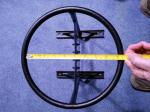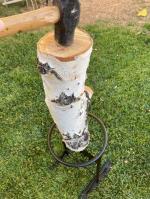I had high hopes for this splitter as a portable, use anywhere splitter. But to to frank, unless you have it mounted on a stump or other firm structure you will be hard pressed to split whole logs.The concept of the splitter is great. Place you piece of wood over the v-shaped blade, give it a whack, and voila, you have split wood. In part, this is true for most species of wood.The manufacturer mentions you can use this anywhere. They even have a picture of it next to the fireplace. Do not use this inside, unless you do not like your floor. The energy transferred from your hammer, through the wood, to the floor, will eventually damage the floor.To properly use this splitter you must bolt it to a fixed structure (like a tree stump). If you don't do that, there will be too much vibration in the splitter, and that translates to wasted energy. Don't try to anchor this to hard dirt or grass, again there will be too much vibration.My first test was trying to split some already split Hotwood brand firewood. These are dried pine alder, and spruce, that has been split already. This splitter had no problem splitting those pieces even further. Then I tried a dried log of birch (cut a year ago). The log was about 3-4" in diameter. The splitter had troubled catching on, but after a dozen whacks it was split. For my last test I tried a green piece of birch cut just a month ago. The splitter barely made a dent.From the tests, I can see this splitter works great on dried split wood. Whole logs and green wood is a different story. The birch log that was not dried may haver been an unfair test, but I wanted to see its limit. Birch is pretty hard and I wanted to see how it would perform. Not having the splitter bolted to a firm hard base probably played a major role, but if that is a requirement, then this splitter (and all others in this category) should not be considered portable.



